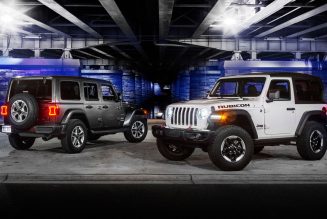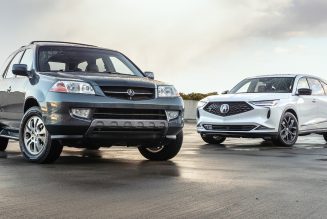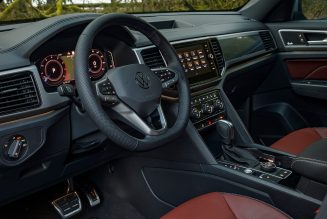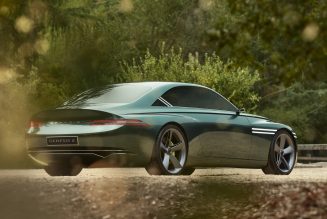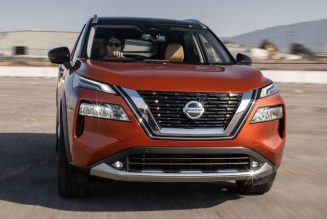When the new 2021 Toyota Sienna minivan debuted last year, it was a bit of a shock that the lineup was hybrid-only. But the move makes sense: In order to differentiate itself from the rest of the minivan pack, Toyota left the traditional powertrain behind while still offering a competitive price. The Sienna is also the only minivan to offer all-wheel drive with a hybrid setup. And although the nameplate has spent most of its life aligned closely with the Honda Odyssey and Chrysler’s vans (currently the Pacifica), the hybrid-only move and bold styling set this generation farther apart.
Meanwhile, the 2021 Honda Odyssey doesn’t feel as avant garde as the Sienna, but it continues to deliver on the basics that make a minivan great. The Odyssey is the most popular minivan nameplate sold in the U.S. market, and it received some minor upgrades for the 2021 model year. Updates include making the Honda Sensing safety technology bundle standard across the lineup, as well as other small changes like second-row seat backs that fold flat.
These minivans certainly look different on the outside, but each continues to foster followers among America’s families, thanks to thoughtful features for adults and children. So, which is better? We drove the 2021 Toyota Sienna and 2021 Honda Odyssey back to back and spent ample time aboard each one to find out.
Minivan Features
Sit in the Toyota Sienna’s front seats, and you’ll find a thoughtfully considered cabin layout. The bridge-like center console is a useful and clever design that allows front passengers to place large items like a purse in the bottom while having easy access to cupholders and cubbies up top. A wide tray that runs along the front passenger’s dashboard is deep enough to accommodate your wallet, phone, or keys, and there’s a deep storage compartment that can keep items like digital tablets from prying eyes. The armrests are not adjustable, but the driver’s seating position is still comfortable.
The Honda Odyssey, on the other hand, has a more traditional front compartment. There’s wide, open space you can use to place big items like a purse, grocery bag, or even a briefcase. As in the Sienna, a deep center console can hide valuables, although this one seems more spacious. Instead of a traditional shifter like the Sienna’s, the Odyssey uses a push-button gear selector, which helps increase the perception of openness within the cabin.
Our Sienna Platinum test minivan came with second-row seats that slide back through more than 20 inches of travel to provide plenty of legroom. There’s also an option to add built-in footrests, but it’s not available in all-wheel-drive versions like the one we tested. Two USB ports (one type A, one type C) are located at the back of the center console, but their location is not exactly ideal; passengers need a longer cable in order to sit comfortably while plugged in.
The Odyssey plays a different game: Its MagicSlide seats can move fore, aft, and sideways, which not only provides the interior with more versatility but also leaves more room for passengers to enter the third row. People who might have some difficulties getting into vehicles—like elderly parents, for instance—will find less of a struggle to access the third row. Two USB-A ports are located on the back of the center console, and, as in the Toyota, they require a long cable in order to charge and use your device.
Once you make it into the third row, the Sienna’s small window makes things feel a bit claustrophobic, but the seating position and comfort are great. Two USB ports (one type A, one type C) are located on the right side, which means whoever sits on the left side of the third row will need an extra-long cable to charge and use their device. There are, however, headphone jacks on both sides for the optional rear-seat entertainment package.
The Odyssey’s third row feels more spacious thanks to larger windows. Unlike the Sienna, there’s only one USB port in the third row, but there are two headphone jacks for the rear entertainment package. We disliked the location of the air vents on the pillars instead of the ceiling: The effect of airflow is enhanced when the vents are located closer to your head, and it makes a huge difference on hot days.
Although both minivans are quite spacious for passengers, cargo room is better in the Odyssey. It offers 38.6 cubic feet behind the third row, compared to 33.5 in the Sienna.
The Drive
The Sienna’s heart is a 2.5-liter l-4 engine mated to two electric motors that deliver 245 combined horsepower. An electronically controlled continuously variable transmission sends power to all four wheels. This combination allows the Sienna to deliver an eye-popping 35 mpg combined, which makes it 60 percent more fuel efficient than the Odyssey.
However, this powertrain comes with caveats. The engine feels stressed even when driving at city-street speeds, and it makes a noticeable din. We also noted a brake pedal that was hard to modulate—the regenerative brakes had us pressing the pedal harder, as we felt like the initial bite wasn’t enough to slow down. The first sensation is soft and squishy before the brakes bite and the vehicle begins to slow.
On broken pavement, the suspension did a nice job of keeping vibrations out of the cabin, and on a couple of twisty hills, the body felt well controlled. The steering is tuned on the lighter side, but it feels balanced.
The Odyssey is only available with a 3.5-liter V-6 that produces 280 hp and 262 lb-ft, which is punchier and more dynamic than the Sienna. Its 10-speed transmission is quick to shift and does so in a smooth manner. Its 22-mpg combined rating is way down from the Sienna’s, but the driving experience is livelier in the Honda. You note its extra power and torque, especially when merging on the freeway. The Odyssey’s respectable 3.3-second time to accelerate from 45 to 65 mph can make a significant difference in passing on a two-lane road compared to the Sienna’s 4.1 seconds.
Overall, the Odyssey shares the familiar driving characteristics we find in other Honda vehicles, such as excellent brake feel, nicely weighted steering, and a slightly oversprung ride that can cause the wheels to patter over rough pavement.
Safety
Both Toyota and Honda prioritize safety across their lineups, which is why we see the Toyota Safety Sense and Honda Sensing bundles baked into most of their vehicles. Both the Sienna and Odyssey include their maker’s systems standard, boasting features like adaptive cruise control, lane keep assist, and automatic emergency braking, among others. This is another reason both minivans scored the Top Safety Pick+ rating from the IIHS, the highest possible.
In terms of the active systems we tested, the Sienna’s lane keeping setup was better at keeping the minivan centered in its lane while keeping a safe distance from the car in front. The Odyssey’s works well, too, but there was a portion of our drive where it had a difficult time reading lane lines the Toyota cruised with no issues.
Decision Time
We asked Honda and Toyota to send us their most fully equipped models, and despite both being outfitted similarly, their prices were quite different. The 2021 Toyota Sienna Platinum’s $54,138 price is higher than the 2021 Honda Odyssey Elite’s $49,390, but we’d chalk that up mostly to powertrain and all-wheel drive. The standard hybrid setup makes the Sienna a bit pricier than other minivans when comparing base stickers, but customers are likely to recoup some or all of the premium in fuel savings.
Both minivans are well equipped and tailored to satisfy families, but overall we preferred the 2021 Honda Odyssey’s spaciousness, fantastic packaging, and more confidence inspiring chassis and handling. We’re fans of the 2021 Sienna‘s thoughtful center console and fuel efficiency, but its comparative lack of overall refinement puts it in second place in this showdown.
2nd Place: 2021 Toyota Sienna
- Smart center-console design
- Sliding seats have lots of travel
- 35 mpg combined, even with AWD
- Powertrain feels stressed
- Vague brake pedal
- No family-monitoring camera
Verdict: The Sienna has racy styling and a properly useful interior, but it lacks refinement on the road.
1st Place: 2021 Honda Odyssey
- Spacious cabin
- Versatile interior
- Competitively priced
- Its technology feels dated
- Mediocre fuel economy
- Short on USB ports
Verdict: The Odyssey doesn’t feel as modern as the Toyota, but it still does more things right.
| POWERTRAIN/CHASSIS | 2021 Honda Odyssey Elite | 2021 Toyota Sienna Platinum Hybrid AWD |
| DRIVETRAIN LAYOUT | Front-engine, FWD | Front-engine, AWD |
| ENGINE TYPE | 60-deg V-6, alum block/heads | I-4, alum block/head, plus rear permanent-magnet electric motor |
| VALVETRAIN | SOHC, 4 valves/cyl | DOHC, 4 valves/cyl |
| DISPLACEMENT | 211.8 cu in/3,471 cc | 151.8 cu in/2,478 cc |
| COMPRESSION RATIO | 11.5:1 | 14.0:1 |
| POWER (SAE NET) | 280 hp @ 6,000 rpm | 189 hp @ 6,000 rpm (gas), 180 hp (elec), 245 hp (comb) |
| TORQUE (SAE NET) | 262 lb-ft @ 4,700 rpm | 176 lb-ft @ 4,400 rpm (gas), 199 lb-ft (elec) |
| REDLINE | 6,800 rpm | Not indicated |
| WEIGHT TO POWER | 16.2 lb/hp | 19.5 lb/hp |
| TRANSMISSION | 10-speed automatic | Cont variable auto |
| AXLE/FINAL-DRIVE RATIO | 3.61:1/1.87:1 | NA |
| SUSPENSION, FRONT; REAR | Struts, coil springs, anti-roll bar; multilink, coil springs, anti-roll bar | Struts, coil springs, anti-roll bar; multilink, coil springs, anti-roll bar |
| STEERING RATIO | 14.4:1 | 14.3:1 |
| TURNS LOCK-TO-LOCK | 3.0 | 3.0 |
| BRAKES, F; R | 12.6-in vented disc; 13.0-in disc, ABS | 12.9-in vented disc; 12.5-in vented disc, ABS |
| WHEELS | 7.5 x 19-in cast aluminum | 7.5 x 18-in cast aluminum |
| TIRES | 235/55R19 101H Bridgestone Turanza EL440 (M+S) | 235/60R18 102V Bridgestone Turanza LS100 (M+S) |
| DIMENSIONS | ||
| WHEELBASE | 118.1 in | 120.5 in |
| TRACK, F/R | 67.3/67.2 in | 67.7/68.5 in |
| LENGTH x WIDTH x HEIGHT | 205.2 x 78.5 x 69.6 in | 203.7 x 78.5 x 68.5 in |
| TURNING CIRCLE | 39.6 ft | 38.3 ft |
| CURB WEIGHT | 4,541 lb | 4,781 lb |
| WEIGHT DIST, F/R | 55/45% | 53/47% |
| TOWING CAPACITY | 3,500 lb | 3,500 lb |
| SEATING CAPACITY | 8 | 7 |
| HEADROOM, F/M/R | 38.7/39.2/38.3 in | 40.1/39.3/37.4 in |
| LEGROOM, F/M/R | 40.9/40.9/38.1 in | 40.3/39.9/38.7 in |
| SHOULDER ROOM, F/M/R | 63.1/61.6/60.0 in | 62.4/62.7/58.5 in |
| CARGO VOLUME, BEH F/M/R | 140.7/91.0/38.6 cu ft | 101.0/75.2/33.5 cu ft |
| TEST DATA | ||
| ACCELERATION TO MPH | ||
| 0-30 | 2.6 sec | 2.4 sec |
| 0-40 | 3.7 | 3.8 |
| 0-50 | 5.2 | 5.5 |
| 0-60 | 6.7 | 7.6 |
| 0-70 | 8.7 | 10.1 |
| 0-80 | 11.1 | 13.0 |
| 0-90 | 13.8 | 16.6 |
| PASSING, 45-65 MPH | 3.3 | 4.1 |
| QUARTER MILE | 15.2 sec @ 94.5 mph | 15.8 sec @ 87.8 mph |
| BRAKING, 60-0 MPH | 123 ft | 125 ft |
| LATERAL ACCELERATION | 0.75 g (avg) | 0.82 g (avg) |
| MT FIGURE EIGHT | 29.1 sec @ 0.56 g (avg) | 28.2 sec @ 0.59 g (avg) |
| TOP-GEAR REVS @ 60 MPH | 1,500 rpm | NA rpm |
| CONSUMER INFO | ||
| BASE PRICE | $48,995 | $51,635 |
| PRICE AS TESTED | $49,390 | $54,138 |
| AIRBAGS | 8: Dual front, front side, f/m/r curtain, front knee | 10: Dual front, front side, middle side, f/m/r curtain, driver knee, passenger thigh |
| BASIC WARRANTY | 3 yrs/36,000 miles | 3 yrs/36,000 miles |
| POWERTRAIN WARRANTY | 5 yrs/60,000 miles | 5 yrs/60,000 miles* |
| ROADSIDE ASSISTANCE | 3 yrs/36,000 miles | 2 yrs/unlimited miles |
| FUEL CAPACITY | 19.5 gal | 18.0 gal + 1.9 kWh Ni-MH battery |
| EPA CITY/HWY/COMB ECON | 19/28/22 mpg | 35/36/35 mpg |
| ENERGY CONS, CITY/HWY | 177/120 kWh/100 miles | 96/94 kWh/100 miles |
| CO2 EMISSIONS, COMB | 0.87 lb/mile | 0.55 lb/mile |
| RECOMMENDED FUEL | Unleaded regular | Unleaded regular |
| *Hybrid system coverage extends to 8 yrs/100,000 miles, hybrid battery coverage to 10 yrs/150,000 miles |


